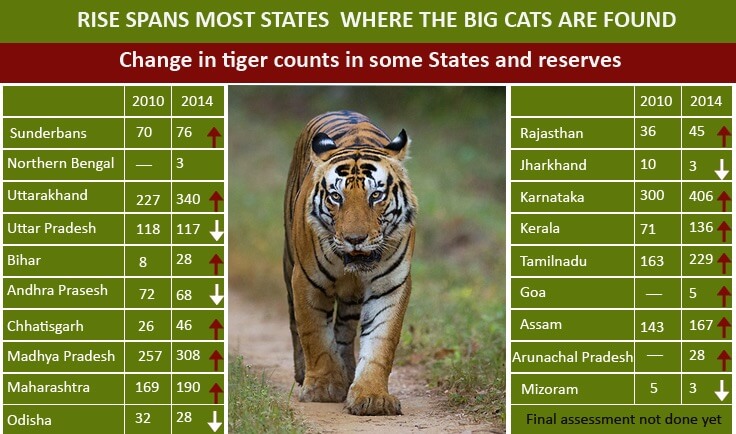Wildllife: What are main causes for Tiger’s Extinction? How to Mitigate it? My Analysis

Only 7% of the tiger habitats in the world still contains tigers. India has 62% of all global Tigers in the Wild. There are hardly 3500 tigers globally (in the wild – Zoo numbers are not counted). At the rate they are killed/poached, they will not last for another 5 years. Really a very pathetic condition 🙁
Let me analyze what are the factors that are leading to their extinct.
(a) Habitat Loss
Biggest concern is the habitat loss. The fact that the forest covers are being cleared at an alarming rate is hugely impacting the lives of the big cats. They are highly territorial and solitary and are not only deprived of proper shelter but also face a shortage of animals to hunt. This is why tigers move out and start feeding on livestock and some actually turn man-eaters. This leads to human-tiger conflict and whenever that happens we all know what happens 🙁 It ends with tigers getting brutally killed by the humans.
Solution: We need to consciously work on increasing the natural habitat as we in India has the least area reserved for Forests and that is depleting at a faster rate (and of course leading to deforestation, and hence higher average temperatures and hence loss of rains…)
(b) Poaching & Illegal Trade
Tigers are being killed indiscriminately for their skin, claws, teeth and bones. The tiger skin is a very costly and luxurious item and sought after in the west and among the rich and the luxurious. Its bones, teeth and claws are said to have magical medicinal properties and are of high demand especially in China and Thailand (but it has been proved that it is more of fantasy than fact). In spite of legal actions against poaching and appointing forest guards, the big cats are not safe even in the sanctuaries. Cruel cases of poaching are common here.
Solution: Wish I knew but what I have learnt is that local tribals are bribed with cash & liquor to help them poach these tigers and without their (tribals) help, it is almost impossible to poach these big cats. Brining these tribals into inclusive economic growth will surely put brakes on poaching. We earn huge amount of travel revenue because of wildlife and we need to find a way to part it to the locals and not just leave it to the big guys & the government. Also we need to add Anti-poaching tax for all these travel revenues (resorts booking, safari booking etc.) and use this money to upgrade our technology gadgets which are specifically meant to arrest these poachers and their methods (which are widely used in South Africa and elsewhere).
(c) Unregulated Tourism
(here is a nice post titled “The Darker side of Tiger Tourism”)
Unfortunately and not surprisingly unregulated tourism is adding to its peril. Huge vehicles, too many safari rides & vehicles at the same time, littering and noisy tourists affect the already traumatized tigers. They move further deep into the forest, letting go of their favorite patches of the forest leading to more territorial fights and hence leading to less tigers.
Solution: Forest Departments should limit the number of vehicles as well as the number of rides and bring in strict safari behavior with no littering whatsoever. no noise, no cellphone usage etc. (easier said than done), and may be distribute the vehicles across more area and then put all of them in the bigger zone than just the limited buffer zone (debatable I know).
In spite of all these hurdles, Tiger population in India, which consists 62% of global tigers (in the wild) has grown 30% over the last five years with number standing at 2226. Karnataka State has the highest number with 408 tigers, mostly in the age group of 1.5 and above. The state is followed by Uttarakhand with 340, Madhya Pradesh with 380 and Tamil Nadu with 229. Maharashtra, Assam, Kerala and Uttar Pradesh has 190, 167, 136 and 117 respectively. Though the world’s tiger population is still falling, the increase in the number in India gives a new hope about the big cats continuing to reign the forests.
Wildtrails of India – “Aggregator App for your Wildlife Trip”
(We are Indian Wildlife Spotting, Sighting, Posting & Sharing mobile app which brings all of Wildlife Enthusiasts (WE) together to post/share their sightings, to connect, and to plan & book their next safari together (Safari Share). To facilitate all of this, brings all of Indian wildlife tourism ecosystem into one place (Wildlife Tourism Aggregator App) – Wildlife National parks, (bird & animal) Sanctuaries, Tiger & Elephant reserves, Wildlife Resorts, Wildlife tour operators & organized tours, Camera/Equipment Rentals, Cab/Car Rentals, Workshops, info about Indian Animals & birds and lot more. Currently we are covering Bandipur & Nagarhole (Kabini & Near Coorg) National Park Tiger Reserves & Bird Sanctuaries close to Bangalore.)
PS1: The app will be released soon and will be charged $5 but those who register to our Beta program, the app will be free; please do sign up for the program here at info@wildtrails.in
PS2: Please be a responsible wildlife tourist; While in the forest – no littering, no sounds, no feeding, no getting down from the safari jeep, no calls (put your cell phones to airplane mode or switch off). Remember we are visiting their home and when we are there, let’s follow their rules.
With 4 years of Sightings data + Extensive expert tracker network in jungles, our customers had the best wildlife experiences.
Buy Wildlife Fashion Accessories
Exclusive Online Store for wildlife products
Packages
Packages Loading...
Recent Posts








